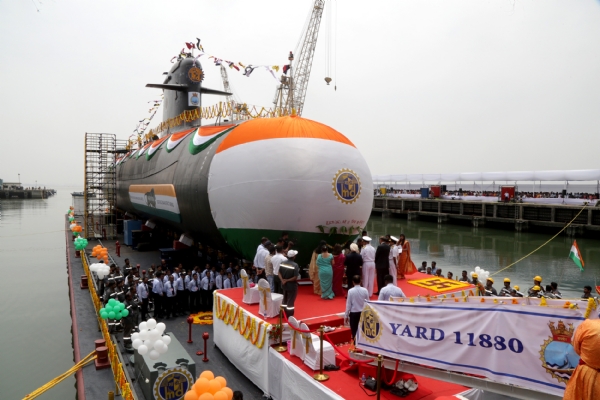Sixth Scorpene Submarine
The sixth and last submarine of the Indian Navy’s Kalvari-class submarines of Project 75 was launched on 20 April at the Kanhoji Angre Wet Basin of Mazagon Dock Limited (MDL). It is being manufactured jointly with the Naval Group, France. The first of the P-75 submarines was inducted into the Navy in December 2017.
The sixth submarine will now commence setting to work on various equipment and harbour trials. The crew will thereafter sail the submarine for the rigorous sea acceptance trials after which it would be delivered to the Indian Navy by late 2023.
These six submarines will add to the Navy’s underwater capability as most of the 15 conventional submarines with India are more than 25 years old.
Project 75 (India)
The decision on Project 75 (India) is getting delayed and even if it gets the go-ahead it might take another two years to begin. Project-75(I) envisages indigenous construction of six modern conventional submarines with contemporary equipment, weapons and sensors including AIP (Air Independent Propulsion), advanced torpedoes, modern missiles and state of the art countermeasure systems.
This would provide a major boost to the indigenous design and construction capability of submarines in India, in addition to bringing in the latest submarine design and technologies as part of the project.
While P-75 is reaching the end of its cycle the contract for the next six should have been signed as it would lead to a gap of a few years again till the next set of submarine construction will start. The contract for P-75 was signed in 2005. Earlier, in 1994 India manufactured two German submarines but the gap of 11 years led to loss of this specialised skill.
Next-Gen Offshore Patrol Vessels
Goa Shipyard Limited has emerged as the leading shipyard to build the Indian Navy’s next generation off-shore patrol vessels (NGOPVs) and eight fast patrol vessels for the Indian Coast Guard. A contract for seven NGOPVs valued at around Rs 9,000 crore is expected to be signed with GSL while four will be built by another shipyard.
The naval off-shore patrol vessels will play a key role in protection of offshore assets, undertaking mine countermeasure operations through modular payloads and also aid special operations.
GSL has undergone various modernisation. It emerged as L1 (lowest bider) for a contract to build fast patrol vessels for the Indian Coast Guard and to build the Navy’s next generation off-shore patrol vessels.
In 2018, the Defence Acquisition Council (DAC) had approved the procurement of six indigenously designed NGOPVs for the Indian Navy at an approximate cost of Rs 4,941 crore. The contract was awarded to the Anil Ambani-owned Pipavav Shipyards but was ultimately scrapped due to several delays. The defence ministry then increased the number of platforms for the Indian Navy to 11 in December 2020 and a tender worth over Rs 9,000 crore was floated, which GSL is now on the verge of bagging.
The NGOPVs will strengthen India’s maritime security as the acquisition of the advanced patrol vessels will help the navy track and counter the steady rise in the deployment of Chinese research vessels in the Indian Ocean Region and in Indian waters.
Multi-purpose Vessels Deal with L&T
The Ministry of Defence, on 25 March, signed a contract with Indian conglomerate, Larsen & Toubro Ltd. (L&T) for the acquisition of two multi-purpose vessels (MPVs) for the Indian Navy. The Rs 887 crore deal was signed under the “Buy-Indian” category. Delivery of vessels is scheduled to commence from May 2025.
MPVs will be the first of its kind platform, constructed to provide a cost-effective solution to meet a variety of requirements of the Indian Navy. These vessels, to be built by L&T shipyard at Kattupally (Chennai), will perform multi-role support functions such as maritime surveillance and patrol, launching/ recovery of torpedoes and operation of various types of aerial, surface and underwater targets for Gunnery/ ASW firing exercises.
These vessels would also be capable of towing ships and rendering Humanitarian Assistance and Disaster Relief (HADR) support with limited hospital ship capability. They will also act as a trial platform for naval weapons and sensors under development, a support platform for ISV and salvage operations, and to provide logistics support for India’s island territories.
High-speed Interceptor Boats Inducted
The Indian Navy inducted two Fast Interceptor Craft (FICs) into its fleet in Kolkata, on 16 March, to beef up its coastal security. The vessels will enable enhanced riverine patrol on the Hooghly river as well as gradually extend patrolling capability seawards.
The high-speed vessels – T323 and T324 – capable of operating in shallow waters were acquired for Sagar Prahari Bal, a unit of the Navy created post 26/11 Mumbai terror attacks as part of the coastal security construct.
The high-speed vessels can operate in the Hooghly as well as in the Bay of Bengal at sand heads and can reach speed of up to 45 knots. The FICs positioned by the Indian Navy will augment the Coastal Security capability of the Indian Navy in the State of West Bengal.


















